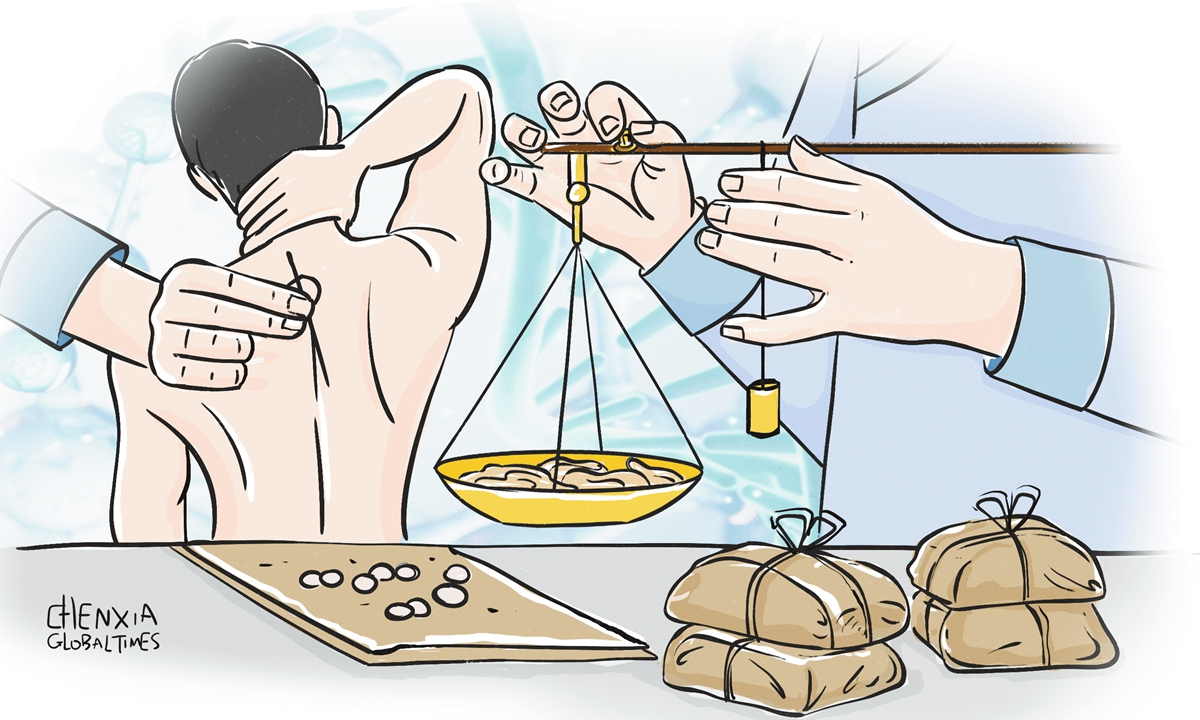ARTS / FILM
Why ancient TCM can bridge global health

Illustration: Chen Xia/GT
Traditional Chinese Medicine (TCM) has long been a treasure of Chinese culture that plays an indispensable part in global medicine.The 2024 World Traditional Medicine Conference was held in Beijing on Tuesday and Wednesday. China is willing to work with the international community to foster mutual learning in traditional medicine, integrate them more deeply into the global health system, and promote the innovative transformation and development of traditional medicine culture, according to a report by Xinhua.
With the theme of Diversity, Inheritance, Innovation: Traditional Medicine for All, the conference brought together 611 foreign delegates from 85 countries and regions to engage in in-depth discussions on the development of traditional medicine industries in various countries.
"This is a great opportunity to present the unique advantages of TCM and to enhance international friendship and cooperation," one conference attendee, Liu Zhen, Secretary of the Party Committee of Guang'anmen Hospital, as well as the Principal Investigator of China Academy of Chinese Medical Sciences (CACMS), told the Global Times on Wednesday.
"The diversity of TCM lies in its broad range of applications. It can treat chronic diseases and sub-health conditions that modern medicine struggles to cure, while also offering valuable supplements and insights for modern medical practices," Liu said.
Increasingly recognized worldwide, TCM combines ancient Chinese wisdom with diversity and flexibility.
At the heart of TCM lies its patient-centered approach, emphasizing an individual's constitution, environment, and lifestyle, rather than simply focusing on symptoms or disease alone.
"The charm of TCM lies in its concept of 'differentiated diagnosis and treatment,' which involves personalized medical care based on the patient's constitution and the underlying causes of their illness," Liu said, emphasizing the flexibility of the use of TCM and TCM methods.
The principle of "syndrome differentiation" highlights the importance of understanding the unique nature of each patient, an approach that sets TCM apart from many other medical systems.
This philosophy is not just theoretical but practically applied in diverse treatments such as acupuncture and moxibustion, tuina (massage), cupping and guasha (spooning).
The 53-year-old Wang Manhe still remembers the acupuncture treatment for frozen shoulder.
"Frozen shoulder is a condition that is difficult to fully recover from. At that time, I had acupuncture once a week, with a total of 12 sessions for each course of treatment, and I completed three courses. Combined with tuina and electrotherapy, I slowly started to feel less pain," Wang said.
She noted that she also visited a TCM doctor to treat a cough and got a prescription for "sour plum soup." "TCM is actually involved in many aspects of my life."
There is no need for complex equipment. TCM tools, the small splints used in Chinese osteopathy, the spoons used in guasha, or the cups used in cupping therapy for example, can draw from materials close at hand, so that such treatments can spread easily.
The global popularity of practices like cupping therapy - once considered an esoteric practice - serves as a prime example of TCM's ability to bridge cultures.
As seen at the 2016 Rio Olympics, US swimmer Michael Phelps made headlines with the "cupping marks" on his body, bringing the ancient practice into the global spotlight.
The 2024 Paris Olympics saw similar marks on Chinese athletes like Zhang Yufei and Wang Shun, further cementing the credibility of TCM in the athletic world.
A TCM practitioner surnamed Tian from Beijing's Chaoyang district told the Global Times that athletes often experience localized muscle pain due to intense training and may also suffer from swelling and bruising caused by bumps and injuries.
"Cupping therapy helps to unblock meridians, promote blood circulation, remove blood stasis, and dispel cold and dampness, effectively alleviating localized pain from overuse, as well as swelling and bruising," he added.
TCM's reach is not limited to professional sports or high-profile global events. According to a report by Xinhua in September 2023, TCM's influence has expanded to 196 countries and regions.
The 11th revision of the International Classification of Diseases (lCD), which came into effect on January 1, 2022, includes a chapter on traditional medicine for dual and optional coding, which is based on traditional medicine originated in ancient Chinese medicine, according to the WHO.
TCM institutions like the renowned Tongrentang, a pharmaceutical company with history of more than 300 years, have set up shop in regions such as Africa.
Liu noted that the China-Cambodia Traditional Chinese Medicine Center launched in Phnom Penh, Cambodia, on October 13, 2023 serves as a model of TCM's commitment to both preserving its traditions. In this project, China promotes the spread of TCM locally through training courses, academic forums, and other initiatives.
Additionally, CACMS has developed TCM treatment plans tailored to the local climate, lifestyle, and other factors, achieving significant therapeutic results.
"By combining TCM's differentiated diagnosis and treatment approach with the precision medicine of modern healthcare, we can provide patients with more personalized treatment options," Liu said.
These efforts not only highlight the therapeutic potential of TCM but also promote cross-cultural dialogue, fostering a deeper understanding between the East and West.
The author is a reporter with the Global Times. life@globaltimes.com.cn



